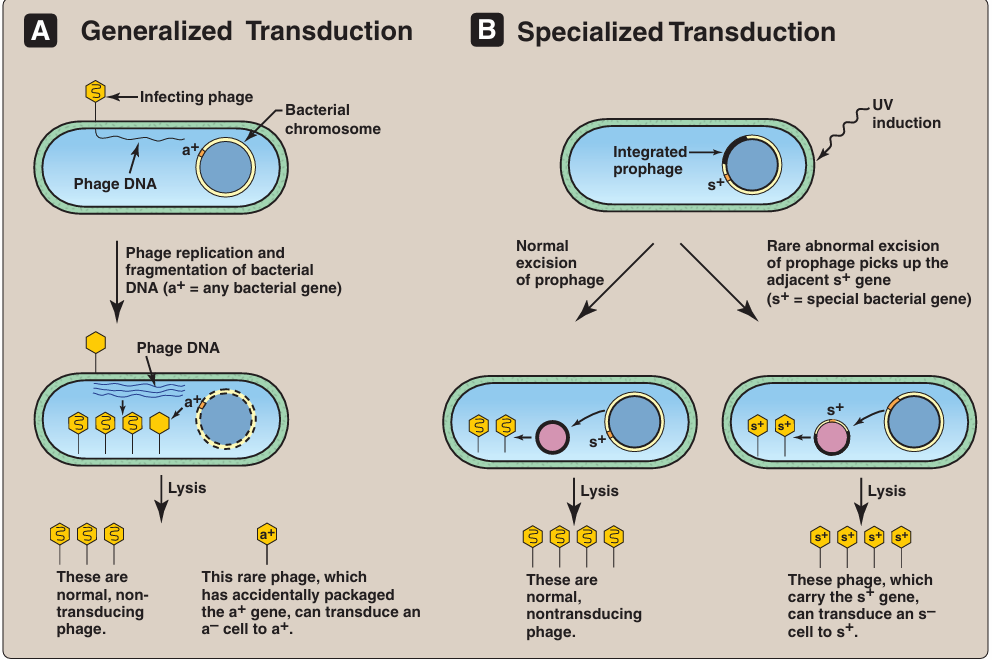
GENE TRANSFER
 المؤلف:
Cornelissen, C. N., Harvey, R. A., & Fisher, B. D
المؤلف:
Cornelissen, C. N., Harvey, R. A., & Fisher, B. D
 المصدر:
Lippincott Illustrated Reviews Microbiology
المصدر:
Lippincott Illustrated Reviews Microbiology
 الجزء والصفحة:
3rd edition , p61-63
الجزء والصفحة:
3rd edition , p61-63
 2025-01-15
2025-01-15
 1017
1017
Genes can be transferred from one bacterial cell to another by three dis tinct mechanisms: conjugation, transduction, and transformation. Because some types of transferred DNA do not contain an origin of replication, these genes will only be passed on to succeeding generations if the transferred DNA becomes incorporated into the recipient chromo some, which has an origin of replication. Plasmids contain their own origin of replication and can, therefore, be maintained in a host through subsequent generations without being integrated into the chromosome.
A. Conjugation
Conjugation is the process by which bacteria transfer genes from one cell to another by cell-to-cell contact. The donor (male) and recipient (female) cells must have the proper genetic constitution to adhere to each other, and they form a cytoplasmic bridge between the cells through which DNA can pass. Specifically, the process requires the presence on the donor cell of a hairlike projection called a sex pilus that makes contact with a specific receptor site on the surface of the recipient cell. This contact results in the formation of a relatively stable cell pair and the initiation of DNA transfer (Figure 1).

Figure 1 Cell-to-cell transfer of a conjugative plasmid (chromosomal DNA is not shown)
B. Transduction
Transduction refers to transfer of genes from one cell to another via a phage vector without cell-to-cell contact. There are two ways in which this can occur: generalized transduction and specialized transduction. In each case, the transducing phage is a temperate phage, so that the recipient cell survives the phage infection.
1. Generalized transduction: In generalized transduction, a random fragment of bacterial DNA is accidentally encapsulated in a phage protein coat in place of the phage DNA (Figure 2 A). When this rare phage particle infects a recipient cell, it injects the bacterial DNA fragment into the cell. If this fragment becomes integrated into the recipient chromosome by recombination, the recipient cell will be stably transduced.
2. Specialized transduction: In specialized transduction, only certain bacterial genes, located on the bacterial chromosome in close proximity to the prophage insertion site of the transducing phage, are transduced (Figure 2 B). The phage acquires the bacterial genes by a rare, abnormal excision from the bacterial chromosome. A specialized transducing phage particle contains both phage and bacterial DNA joined together as a single molecule. After infecting another cell, this joint molecule integrates into the recipient chromo some just as phage DNA normally does in the process of becoming a prophage.
C. Transformation
Transformation is the transfer of genes from one cell to another by means of naked DNA. The discovery of transformation in 1928, one of the most important in all of biology, led eventually to the identification of DNA as the genetic material. Studies of the transformation phenomenon itself revealed that the ability of a cell to be trans formed (called competence) depends on a physiologic state of the cell that allows DNA to cross the cell membrane. As free, double stranded DNA enters the recipient cell, one of the two strands is destroyed by nucleases. The remaining single strand invades the resident chromosome, seeking a region of sequence homology. If such a sequence is found, the invading strand replaces one of the two resident strands by a complex cut-and-paste process.

Figure(2)Certain phage can package bacterial genes and transfer them to other bacteria (transduction). By one mechanism (A) any bacterial gene can be transferred. By a second mechanism (B) only certain genes can be transferred, namely those in close proximity to a prophage.
 الاكثر قراءة في وراثة الاحياء المجهرية
الاكثر قراءة في وراثة الاحياء المجهرية
 اخر الاخبار
اخر الاخبار
اخبار العتبة العباسية المقدسة


